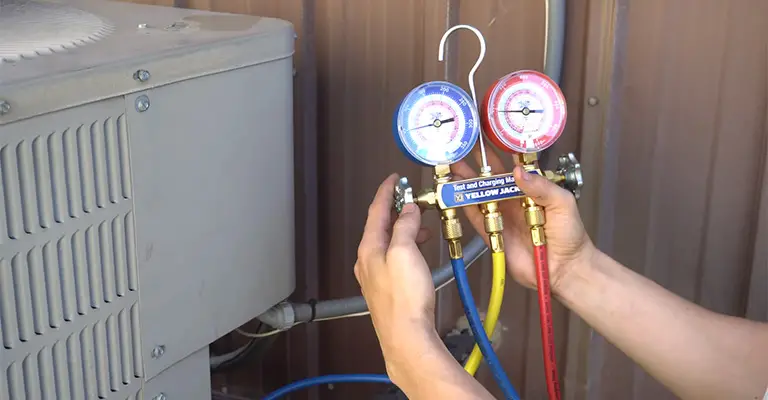Maintaining the optimal refrigerant level in a refrigeration or air conditioning system is crucial for efficient and effective operation.
Insufficient or excessive refrigerant can lead to performance issues, increased energy consumption, and even damage to the system.
Therefore, it is crucial to accurately assess the refrigerant level to ensure proper functioning and prevent potential problems.
Do you have an AC that fails to cool your home correctly? You may have low refrigerant. Nothing is more frustrating than having your home AC system malfunction during the hottest, most humid days of the year.
You cannot relax at home for some reason and are wondering what the problem might be. It can’t adequately cool your home’s air if your AC has insufficient refrigerant.
Let me explain how you can check the refrigerant level in an air conditioner in five simple steps. To understand what a refrigerant is and how it works, let’s first define it.
What Is a Refrigerant?
The refrigerant in your air conditioner chills the warm air from outside so that your home can enjoy cool, fresh air.
Refrigerants operate as vapors or liquids inside your evaporator’s and condenser’s coils to distribute cooler, comfortable air throughout your home.
When people don’t know what refrigerant is, they assume their AC unit has a “cooling component.” Actually, it transfers heat from one place to another.
As warm air enters the system from outside, the refrigerant absorbs the heat and turns it into a liquid.
When warm air passes over the coils, the refrigerant inside them begins to cool, converting into a gas. Your home is then cooled by the warm air being blown over the cooled coils.
Each air conditioner uses a continuous cycle to transfer heat energy into cool, comfortable air. A low refrigerant level will affect your air conditioner’s cooling, and you’ll experience hot air from it.
Low Refrigerant Level Signs
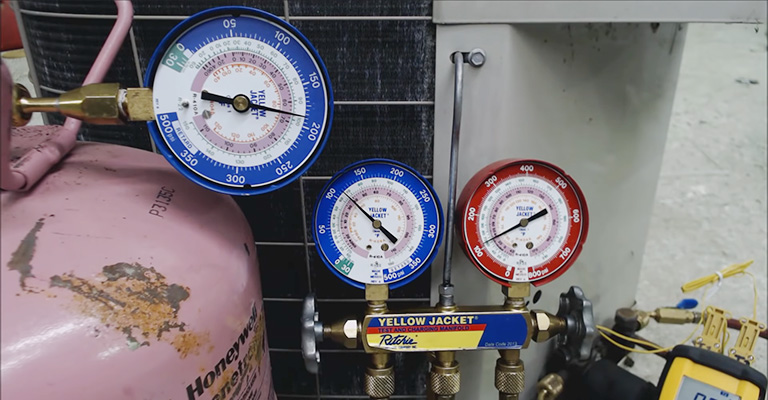
If you’ve noticed warm air circulating throughout your home despite turning down the thermostat, this could be a sign that your refrigerant levels are low.
You may have another reason your AC isn’t working, such as dirty filters or dirt built up on coils, but low refrigerant levels are relatively common. The following steps will let you know if your refrigerant levels are low:
Increased Energy Bills
Heat cannot be transferred as effectively when your air conditioner has low refrigerant levels. The AC must work harder and longer than necessary, leading to higher energy bills.
Ice Found On AC Unit
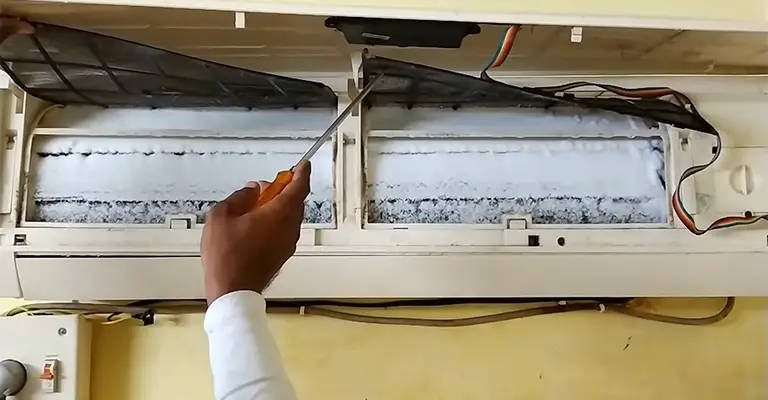
Low refrigerant levels can sometimes result in ice or frost on your AC. A drop in temperature leads to ice forming on the evaporator coil because of the cold.
Hissing Noises
If you hear a hissing noise coming from your AC unit that you aren’t familiar with, it may be a refrigerant problem. Depending on the severity of the refrigerant leak, you may hear hissing or bubbling.
A refrigerant leak in your AC unit can be detected by washing it with soap. You should mix soap and water in a bowl and place it underneath where you think the refrigerant is leaking out. Bubbles in the soap are usually an indication of a leak.
If you have an electronic leak detector, you can use it. The device is also called a sniffer, as it has a virtual leak indicator. As a result of detecting a leak, it can also emit noise.
The different electronic leak detectors available on the market may not be accurate when it’s windy.
Warm Air From The Supply Vents
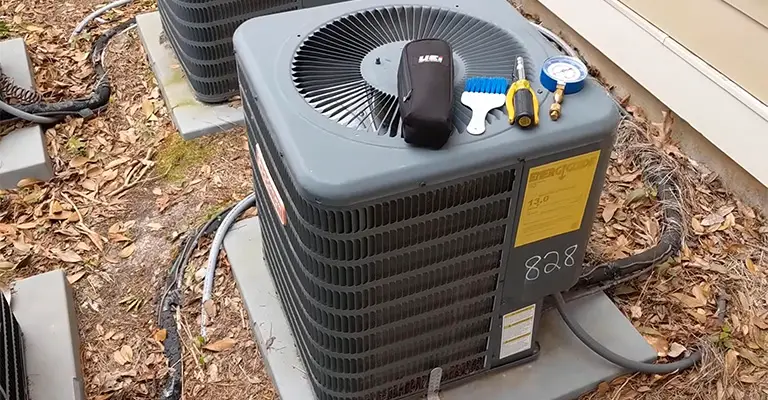
When refrigerant levels are low, the AC cannot absorb sufficient heat each cycle. In this way, the supply vents are able to blow warmer air.
Warm air can also come from supply vents when the filters are clogged, the compressor is malfunctioning, or the thermostat is set incorrectly.
The refrigerant levels can be checked in a few steps if your home is experiencing all these issues and has warm air circulating.
For expert help, call your local HVAC company. Certified HVAC technicians can also perform this service.
How to Check Refrigerant Levels in AC
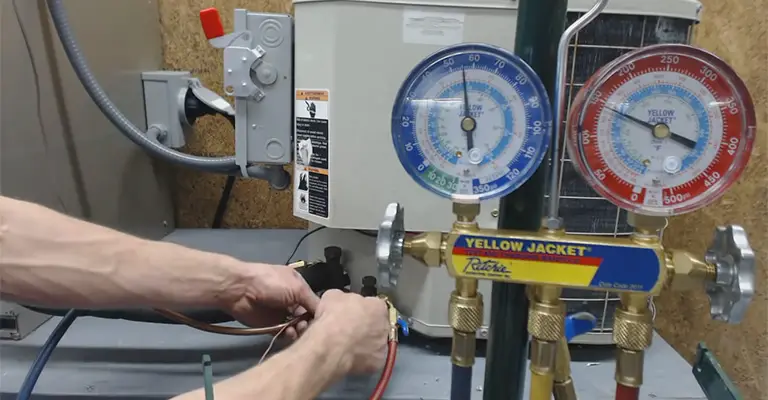
It’s OK if you’re unfamiliar with how to check the refrigerant. Using our simple five-step guide, you can quickly check the levels of your home’s refrigerant.
To make this work, you require a refrigerant slider that you can buy at a hardware store. It’s always better to leave HVAC repair to the professionals if you don’t have one.
1. Confirm What Type Of Refrigerant You Have
Make sure your AC unit operates with the correct refrigerant. This information should appear on your AC unit’s type plate. The brand of refrigerant in your unit may be different from Freon.
2. Check The Refrigerant Pressure
The next step is checking the pressure after determining the type of refrigerant. Low Freon levels correspond to low refrigerant pressure.
As well as suction and discharge pressure gauges, your AC system should have high and low-pressure gauges.
3. Take Evaporation And Condensation Readings
Here’s where you must apply a refrigerant slider to determine evaporation and condensation temperatures.
You should set the slider on “dew” to represent evaporation and “bubble” to represent condensation. Write down the temperature on the table.
4. Take Refrigerant Temperature Readings
For refrigerant measurements, it is vital to calculate the temperature difference between subcooling and subheading.
To cool the system properly, the subcooling temperature must be around 5 Kelvin (K), while the superheating temperature should be approximately 10 Kelvin (K).
For properly calculating superheating and subcooling within your unit, you will need a digital thermometer, refrigerant slider, and a way to track your results.
5. Calculate Refrigerant Level
To calculate the temperatures for subcooling and superheating, you first need to collect all necessary data.
You can get the superheating temperature by subtracting the evaporation temperature from the suction pipe temperature. You can subcool by subtracting the discharge pipe temperature from the condensation temperature.
A low refrigerant level is likely found if your refrigerant temperatures are outside the 10K to 5K range (standard for optimal operation). You can contact an HVAC technician to check your refrigerant levels and refill the coolant if necessary.
Tips To Maintain Good Refrigerant Level on AC
The use of air conditioning systems is increasing these days. Air conditioning has become necessary in today’s world, and people are investing in it.
Because of this, it is crucial to know how to maintain your air conditioner correctly. Correct maintenance can also result in the reduction of electricity consumption.
Keep The Room Cool By Closing The Windows And Doors
To keep the room cool, close all the windows and doors when the air conditioner is not in use. Additionally, the use of energy will be reduced as a result of this.
No To Harsh Chemicals
Make sure your AC unit is cleaned without harsh chemicals. Avoid harsh cleaners and use a mild one instead. Make sure you recharge the system when the AC unit has been cleaned using the proper refrigerant level.
Keep The AC Unit Clean
It will not work properly if the AC unit is not clean since the refrigerant cannot stay in the unit as long. You can clean your air conditioning unit using a vacuum cleaner and dust cloth.
Check The Refrigerant Level
Every time the AC goes on and before the cooling starts, it should be checked for levels. The unit may stop cooling altogether if the level drops below the minimum required.
What Are The Advantages Of Checking Refrigerant Level In AC?
Keep your air conditioning system’s refrigerant level checked periodically to ensure that it can keep up with your cooling needs. A refrigerant is a chemical that cools and dehumidifies air.
- It can cause the AC unit to operate inefficiently or even cause a safety hazard if the refrigerant level falls below a certain threshold.
- Keeps track of your air conditioner’s efficiency.
- Analyzes when it is necessary to replace the system.
- Identifies problems before they become major.
- Saves money on costly AC repairs.
Final Words
Once you have checked and confirmed the low AC refrigerant levels, you should call a qualified AC technician to refill and empty the system. It can be costly to refill refrigerants, not to mention that damage can be caused to the AC.
Refrigerant refilling and emptying should only be performed by certified technicians. Checking your air conditioner regularly can prevent common AC problems.

